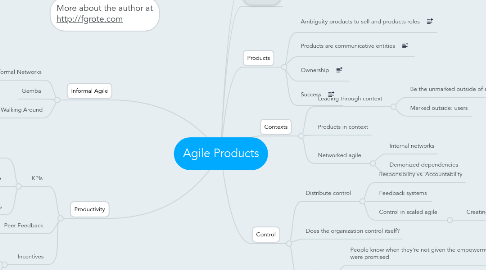Agile Products
par Florian Grote


1. Informal Agile
1.1. Informal Networks
1.2. Gemba
1.3. Management by Walking Around
1.3.1. Relate to individuals
2. Productivity
2.1. KPIs
2.1.1. Business Value
2.1.2. User Value
2.1.2.1. Adoption
2.1.2.2. Retention
2.1.3. Happiness
2.2. Peer Feedback
2.3. Incentives
2.3.1. Kudos System
2.3.2. Team Incentives
3. This mind map reflects the current state of an ongoing research project into the dynamics of new product paradigms and the "agile" methods to create them.
4. More about the author at http://fgrote.com
5. Control
5.1. Distribute control
5.1.1. Responsibility vs. Accountability
5.1.2. Feedback systems
5.1.3. Control in scaled agile
5.1.3.1. Creating jump-off points
5.2. Does the organization control itself?
5.3. Roles
5.3.1. People know when they're not given the empowerment they were promised
5.3.1.1. Danger: Teams assuming the worst
5.3.2. Strategy: Distribute control as a scarce, not abundant resource
5.3.3. People know when change is only stated, but not lived
6. Contexts
6.1. Leading through context
6.1.1. Be the unmarked outside of every distinction
6.1.2. Marked outside: users
6.2. Products in context
6.3. Networked agile
6.3.1. Internal networks
6.3.2. Demonized dependencies
